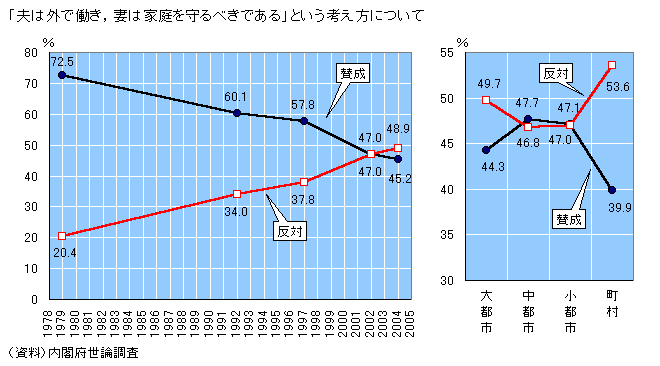Changes in People's Thoughts
about Gender Stereotypes
1. Introduction -Gender Stereotypes-
Some years ago, I read a story as follows.
|
The phone rang at the emergency center. The operator answered, "911. What is your emergency?" The caller said, "A traffic accident just occurred right in front of my house. The drivers are badly injured. They need an ambulance." "What is your address?" "56 Park Place. My name is Robinson, Dr. Robinson. I work at General Hospital..." while the caller was speaking, the operator typed the information into a computer. Several minutes later, the ambulance arrived and the injured drivers were taken to a hospital. Later a police officer came to the house of Dr. Robinson. When he rang the door bell, a young girl appeared. The police officer asked her, "Is this Dr. Robinson's house?" The girl nodded. "Is your father in?" The girl said, "He's away on a business trip. He won't come back till this weekend." The police officer was puzzled and stood wondering why for a moment. Who called the emergency center? |
You might think the young girl was lying to the police officer unless you realized that Dr. Robinson was the girl's mother, not her father. This story shows how gender stereotypes affect your way of thinking. If you thought Dr. Robinson was a man, perhaps you automatically think most doctors are males.
Gender stereotypes - what a man or a woman should be like - are influenced by culture and have changed throughout history.
In this paper, I report the change of the percentage of people with the typical gender stereotyped idea that men should work outside to support the family while women should stay in the home as housewives.
The method of this research was the Internet.
2. Data -From a Survey in Japan-
The graphs below show the results of the survey conducted by the Cabinet office, government of Japan.

In the survey, they asked people if they are for or against the idea that men should work outside to support the family while women should stay in the home as housewives. The percentage of people agreed is shown in black lines and that of people disagreed is shown in red lines.
The horizontal axis of the graph on the right refers to the scale of cities in which the survey was done in 2004. From the left, the labels are "big cities", "middle-sized cities", "small cities", and "towns or villages".
3. Discussion
From the graph on the left, we can clearly see that the percentage of people having the idea that men should work outside to support the family while women should stay in the home as housewives, has decreased constantly for about 20 years since 1979, while the percentage of people against the idea has increased. In 2002, the percentage of people who are against overcame the other. This result is quite natural in the recent social trend of gender equality.
What really interests us is the result from the graph on the right. This shows the percentages of people for and against the idea according to the scale of cities in 2004. Before I saw the result, I had thought that the smaller the city is, the more the "older idea" remains and the percentage of people who agree with the idea would become higher than bigger cities. However, the result is the other way round. 53.6% of the people in small cities or villages think the idea of fixed gender role is wrong.
There can be two reasons for this result.
For one thing, in small cities or villages, where agriculture and fishery have been the main industry, women have played important roles for a long time not only in the homes but also outside the house.
The other reason is family composition. Since many families in rural areas live with members from three generations, women having children can work outside of the houses leaving their children in charge of their parents.
In the future, this percentage will continue to change. Can we make our society one of gender equality where men and women can choose their own life, while respecting each other's way of life? Slowly but surely this is starting to happen.